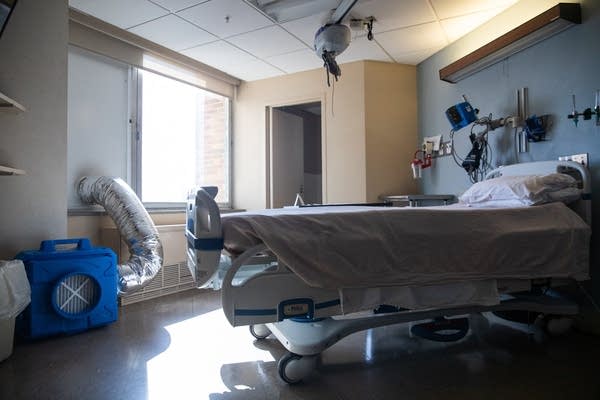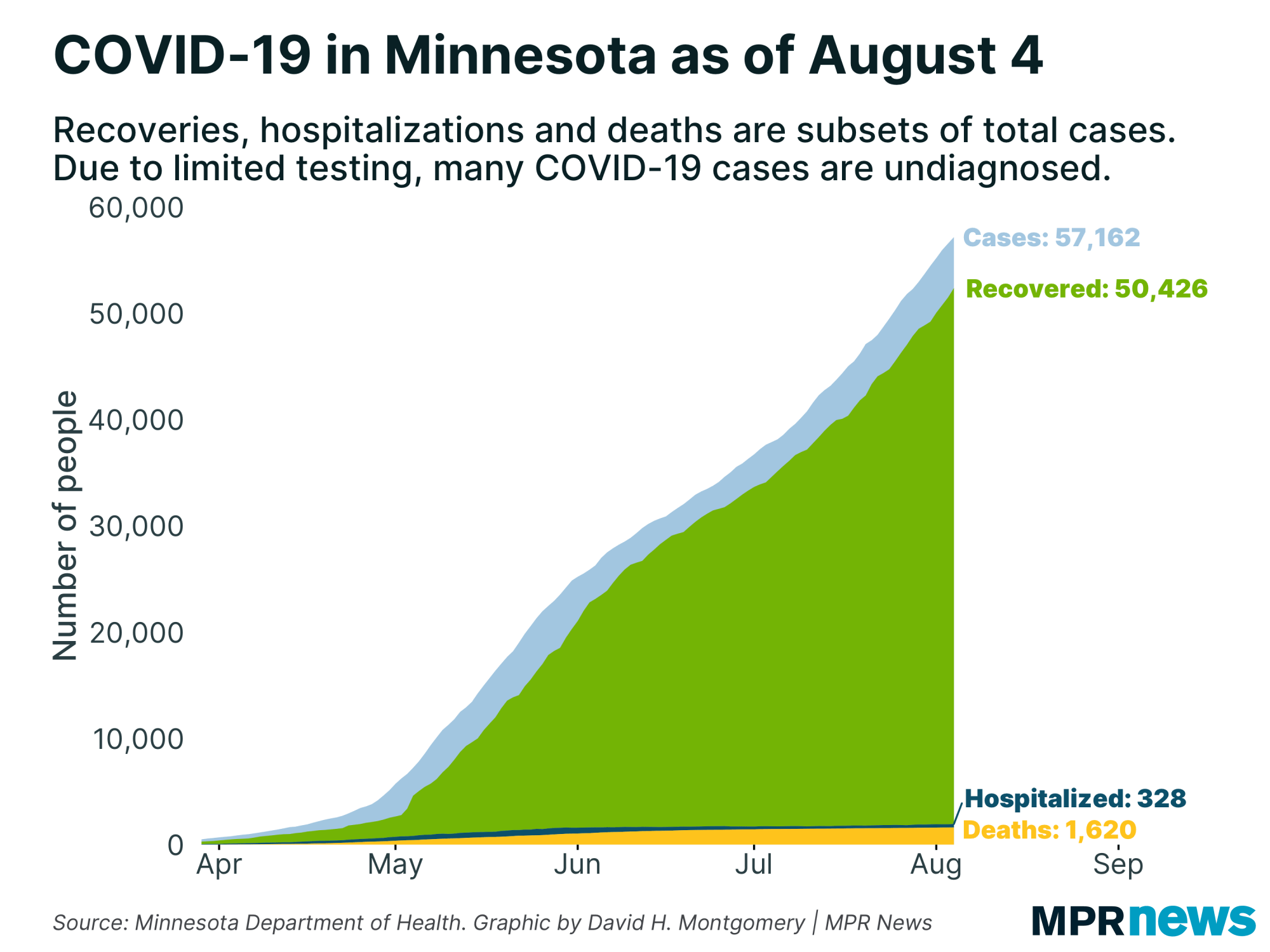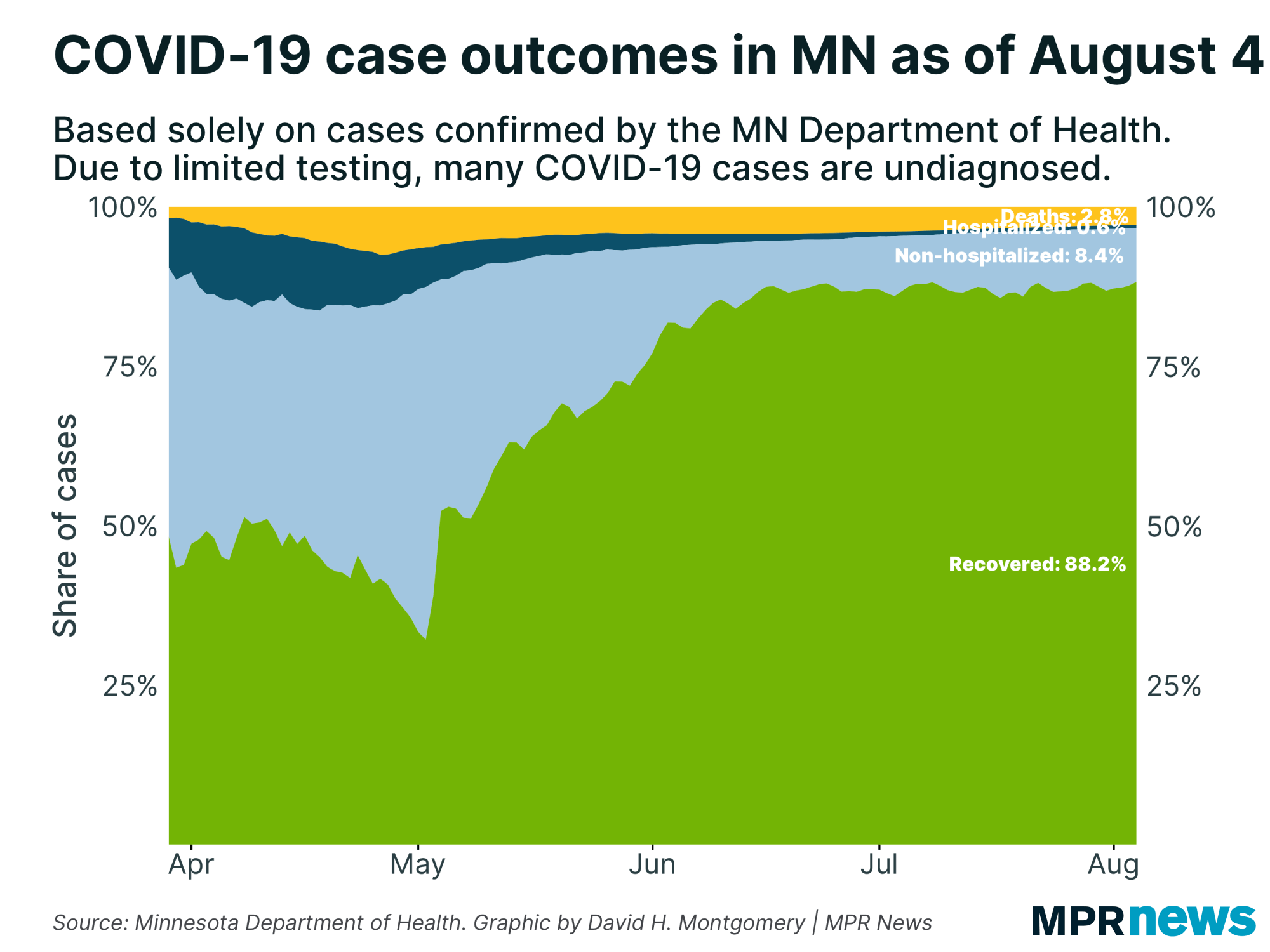May 23 update on COVID-19 in MN: More than 800 new cases as testing ramps up

Updated: 2:00 p.m.
Minnesota saw its greatest one-day jump in confirmed COVID-19 cases, state health officials reported Saturday, as the number of people hospitalized with the disease also reached a new high.
That's as the state exceeded 8,000 completed tests in a day for just the second time.
Meanwhile, the number of newly reported deaths dropped sharply Saturday, and the number of people being treated in ICUs for COVID-19 also fell.
The Minnesota Department of Health reported 847 new confirmed cases of COVID-19 on Saturday, bringing the statewide total to 19,845.
Create a More Connected Minnesota
MPR News is your trusted resource for the news you need. With your support, MPR News brings accessible, courageous journalism and authentic conversation to everyone - free of paywalls and barriers. Your gift makes a difference.
Ten more people died from COVID-19, bringing the death toll to 852. State officials had reported 33 deaths on Friday, and 32 the day before. Most of the people who have died from COVID-19 in Minnesota have been residents of long-term care facilities.
The number of people hospitalized increased to 568, up from 534 in Friday's report. The previous greatest daily high was 566, two days ago.
The number of people being treated in ICUs dropped to 215, from 233 on Friday.
About 64 percent of people who have been diagnosed with COVID-19 in Minnesota have recovered to the point where they no longer need to be isolated.

The tug of war between public health and the desire for normalcy in the COVID-19 era was on full display Friday as Minnesotans mourned the State Fair’s cancellation and debated the relative risk of large religious gatherings.
State health officials continued to plead with Minnesotans to stay vigilant against the virus — wearing masks in public and social distancing — and reiterated that people without symptoms can unknowingly spread COVID-19, putting others in danger.
Health Commissioner Jan Malcolm said Friday that some hospital intensive care units in the Twin Cities metro area were filling now to the point where they are within 5 percent of normal capacity.
Some of that is due to the steady rise of COVID-19 cases; some due to the resumption of nonelective surgeries. The state has said it could add surge capacity quickly.
State Fair canceled
Minutes after the Health Department released new data Friday morning, State Fair officials announced the 2020 Great Minnesota Get-Together could not go on because of the potential public health risk from the disease.
"We all love the fair and that's exactly why we can't have a fair this year,” said Jerry Hammer, the fair’s general manager.
The event has been canceled before, most recently in 1946 because of a polio epidemic. This year, state health leaders have worried over the prospect of hundreds of thousands of Minnesotans packed in at the fair amid the COVID-19 pandemic.
State officials had expressed skepticism about holding the 12-day event, which more than 2 million people attended last year. In April, Gov. Tim Walz said he had a hard time seeing the fair operating this year.
Fair officials had been telling vendors and participants that they expected to make a final decision far in advance to allow food stands, attractions and exhibitors enough time to plan appropriately.
On Friday, Hammer said the board had heard feedback from fair fans along the lines of, let the healthy people go. “That's not who we are and that's not what we do,” he said. “It's got to be accessible to everybody. And a significant number of folks have some sort of health risk, some sort of compromised health.”
Agricultural exhibitors and entertainers on the nationwide fair circuit already were calling off their appearances, and even without safety concerns a fair this summer would not have looked as it has in recent years, he added.
Malcolm said she did not make a recommendation to fair leaders but did lay out the risks. As hard as it was to cancel, the fair “would have been a pretty predictable accelerator of community spread” she said Friday.
"No way around it, it's just another sad indication of the disruption and the loss,” she added. “It's certainly a huge loss to the people's livelihoods are tied to the fair and it is a cultural loss."
Pushback on COVID-19 curbs
The State Fair decision comes as Minnesota health leaders face growing questions over the toll the state’s COVID-19 strategy is taking on religious services, graduation ceremonies and other important life rituals.
Earlier in the week, Gov. Tim Walz unveiled cautious steps to restart parts of the state’s hard-hit restaurant and bar industry in the COVID-19 era. But it was not the plan those businesses were looking for.
Walz announced that bars and eateries could start to serve sit-down customers beginning June 1 — but only at outdoor tables. He stopped short of letting customers sit inside barrooms, restaurant dining rooms or other indoor tables for now.
And while he loosened other curbs on barbershops and other personal services, he would not put dates to when vital parts of daily life in Minnesota could resume, including indoor religious gatherings of more than 10.
Walz’s moves led to pushback on several fronts. A key hospitality group called the bar and restaurant plan disastrous for an industry already reeling from the economic fallout of COVID-19. GOP leaders also attacked the decision.
The state’s Catholic Church leaders, as well as Lutheran leaders from Wisconsin and Missouri synods, said they would defy Walz’s order and resume services next week, believing they could do so safely.

The questions around religious services got more complicated Friday afternoon when President Trump declared houses of worship essential institutions.
Later in the day a Walz spokesperson said the governor had talked with local faith leaders and that would study the new guidance from the federal Centers for Disease Control and Prevention “to better understand what this means for places of worship in Minnesota.”
“It is going to get worse here before it gets better. That is an absolute guarantee,” Walz said of the expected surge in COVID-19 cases and hospitalizations now expected later this summer. Walz said he expects the state’s death toll to hit 1,000 by the end of the month and 1,500 by late June.
Kris Ehresmann, the state’s infectious disease director, said Thursday that the concern at worship services — including where she worships — is for medically vulnerable people who might be infected. Those at-risk people would naturally want to attend services but “what may seem to be OK for a certain segment of the population could have devastating consequences for others.”
Developments from around the state
State sets free COVID-19 testing this weekend
The governor’s office on Friday said the Health Department together with the National Guard will offer free COVID-19 testing for any Minnesotan who wants it.
The state set up six National Guard Armory locations across Minnesota throughout the Memorial Day holiday weekend, including St. Paul, Minneapolis, Moorhead, Duluth, Faribault and St. James. They'll be open to conduct testing from Saturday through Monday from 10 a.m. to 5 p.m. daily, or until supplies are exhausted.
No appointment is necessary. Minnesotans will not be asked for insurance cards or ID. Results will be provided by phone within about 48 hours.
Officials said the sites will be able to collect roughly 2,000 samples per day across six sites, for a total capacity of roughly 6,000 tests over the three-day weekend.
— MPR News Staff and the Associated Press
Minneapolis to require face masks in indoor public places
Starting next week, people in indoor public places in Minneapolis will be required to wear a face covering.
Mayor Jacob Frey announced the measure on Thursday as the latest in a series of emergency regulations designed to halt the spread of COVID-19. The regulation will take effect next Tuesday.
Frey said business owners will be able to refuse entry to anyone who's not wearing a face covering. The rule would apply to indoor public places in Minneapolis, not outdoor venues.
People can call 311 to report noncompliance, the mayor said. Violations could be punished by fines up to $1,000.
"We are not criminalizing forgetfulness. We are not penalizing people for a lack of awareness. We are approaching the implementation of the policy with grace and patience,” said Frey. “We are prioritizing outreach and education."
On Friday, Frey said that the city has purchased more than 9,000 cloth masks with money from the budgets for council members and the mayor's office. More masks are needed, however, especially in light of the new emergency regulation, Frey said.
The mayor encouraged people to take part in a Memorial Day mask drive, during which people can drop off donated masks at fire stations across Minneapolis.
— Brandt Williams | MPR News
Joblessness in MN jumps to 8 percent last month
Minnesota's unemployment rate more than doubled in April to about 8 percent.
The unemployment rate is based on federal survey of about 900 Minnesota households and the results can be pretty dated by the time they're released. The latest survey indicated about 250,000 Minnesota were unemployed through early April. But as of this week, about 700,000 Minnesotans have filed for unemployment insurance. The unemployment rate will certainly rise.
A survey of employers found Minnesota lost an estimated 360,000 private sector jobs in April, compared with the same month a year ago.
“Almost half of those jobs were lost in leisure and hospitality and other services, which includes personal services, all of the hair dressers and barbershops that were shut down,” said Oriane Casale, interim director of the DEED’s Labor Market Information Office.
— Martin Moylan | MPR News
Top headlines
Efforts aim to share COVID-19 info, help in St. Cloud's Somali-speaking community: As the number of cases of COVID-19 in the St. Cloud area continues to climb, an effort is underway to reach out to the region’s Somali American community with information and assistance.
It was hailed as the 'Minnesota moonshot' — but why hasn’t antibody testing taken off? One reason state health officials say they have been reticent to suggest widespread testing is reliability. In addition to the Mayo and U of M tests, private companies have also developed their own antibody testing. State officials say there are tests on the market that don’t produce reliable results.
More Minnesotans flocking to food shelves: As more Minnesotans lose their jobs because of COVID-19, local food shelves are seeing a surge in first-time visitors needing emergency food services — and the demand doesn’t look like it’ll let up anytime soon. About 1 in 3 Minnesotans say they’re worried about affording groceries and healthy food.
Meet the Minnesota scientists trying to track COVID-19 spread — through sewage: Two University of Minnesota researchers are looking for the virus in wastewater — even before test results reveal its presence in a community.
COVID-19 in Minnesota
Data in these graphs are based off Minnesota Department of Health cumulative totals released at 11 a.m. daily. You can find more detailed statistics on COVID-19 at the Health Department website.
Health officials for weeks have been increasingly raising the alarm over the spread of the novel coronavirus in the United States. The disease is transmitted through respiratory droplets, coughs and sneezes, similar to the way the flu can spread.
Government and medical leaders are urging people to wash their hands frequently and well, refrain from touching their faces, cover their coughs, disinfect surfaces and avoid large crowds, all in an effort to curb the virus’ rapid spread.
The state of Minnesota has temporarily closed schools, while administrators work to determine next steps, and is requiring a temporary closure of all in-person dining at restaurants, bars and coffee shops, as well as theaters, gyms, yoga studios and other spaces in which people congregate in close proximity.